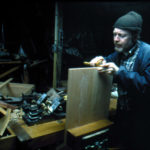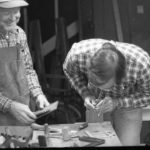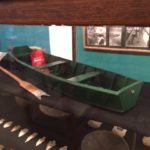200 STORIES, FEATURING DR. JAMES PRICE
Ahead of the U.S. Bicentennial in 1976, the National Endowment for the Arts seeded folklife programs across the country, leading to our own folk and traditional arts program anchored at the University of Missouri. In Missouri’s own bicentennial year, our staff will share 200 stories over the course of 52 weeks in 2021 about folk and traditional arts in the Show Me State. Some of those 200 Stories will land here on the Show Me Folk blog first, as we share portraits composed by some of our favorite community scholars.
For the post below, we thank Marideth Sisco, once again, who put on her journalistic-ethnographic hat to conduct a series of interviews in south central Missouri in 2019. She interviewed James Price, PhD. a sixth generation Ozarkian, with a long career as an anthropologist/archaeologist. Sisco and Price sat for quite some time for the interviews, and there is much information to share. For our purposes in 200 Stories, we’re sharing Doc Price’s recollections on the Current River as a site for river guides and johnboats. For information about his participation in the Traditional Arts Apprenticeship Program, check out his profile in our online exhibition Master Artists/Master Teachers.
ON THE OZARKS RIVERS
Dr. James E. Price as told to Marideth Sisco
Every time I think about johnboat building, I think about how the boat was determined by the boards. Every time we would get into a big pine tree we’d measure to see if we could get a set of 22- or 24-foot boards, enough to get a johnboat out of, because they had to have continuous boards on the sides and continuous boards on the bottom, and so we could make a johnboat up to 32 feet long if we could find boards long enough and wide enough.
Back then a Mr. Carl Shockley, who lived south of Big Spring, he was the source, in my childhood, of the big boards. If we didn’t have boards big enough and long enough for johnboats, we’d go up there and get them from him, because he had the biggest trees.
That place is on the road that comes through from Big Spring to Eastwood. He lived by a place called Cataract Hill. Anyway, we’d take a log truck and load johnboat boards on there, for my dad and my uncles and so forth. We built lots of johnboats over the years because my dad and uncles were all river guides. My family started guiding on that river, the Current River, in 1872. And they guided until the 1970s. So, we went through a lot of johnboats. And that was the thing we did, how we made our living.
In the 1950s, I was on the river most of the summer. We were farmers and had crops and so on, but the real money was in guiding. In 1952, 53, 54, those were drought years, and we lost our crops. We lost the crop in 52, didn’t plant in 53, didn’t plant in 54. Family income came from lots of sources, from livestock, poultry, we had hogs, and so on, but the bulk of the money came from guiding on the river, taking fishermen out to camp and fish. My dad could make $15 a day guiding in the 50s, and that was a lot of money in those days.
It wasn’t local folks that needed guiding. Once the word got out to the outside world that fishing was good on the beautiful Current River, we never ran short of people who wanted to experience it. We had clientele from Chicago and St. Louis primarily, and there were several generations of families who came. Sometimes, my family had guided their grandfathers and their fathers on down. There was a Dr. Kohl from Chicago and a Dr. Schopp from St. Louis who was a brain surgeon, a cranial surgeon. And then we had a bunch of clients who were Jewish and owned a bunch of stores on Cherokee Street in St. Louis. And they would come down every summer for two weeks. And they were kosher in their food habits, and so they did all the cooking. We didn’t have to cook. We always looked forward to that. Morey Zigoloff was one of them, and Larry Scheer, who owned a kosher meat market there on Cherokee Street. And he would bring all these incredible cuts of meat, steaks and brisket. They did the cooking. And we ate high on the hog, as they say. And I learned to really appreciate kosher food. They would bring lox and bagels and the whole thing. They were wonderful people.
They would tip my dad sometimes a hundred dollars, and if they’d had a good trip it might be more than that. They’d just pull out the money and hand it to him. And, so, we did well during that time. And it was good for them, too, because where else could they find someone who could take them there and give them that experience?
My great uncle was the patriarch of our whole operation on the river. Andy, Andrew Price. And, in the winter, when he wasn’t on the river, he ran the projector at Hunt Theater in Doniphan. And, I was with him a lot because I would go up and stay with Andy and Hattie. It was great. They had a house upstairs over a store, and it was only four buildings away from the theater. He would take me down there, and I’d have popcorn and a soda, and I’d get to set up in the projector room with him. And that was back in the days of the old carbon arc projectors, and I bet it was 120 degrees up there, and I just loved it.
Anyway, Andy was kind of a ne’er do well. His life was on the river, and he didn’t retire until he was about 80, and they wrote up a thing in the paper, the Prospect News, about him, and they asked him, you know, “Did you ever turn a boat over.” Now, he had been on the river for 60-something years. And so, they asked him that, and he said, “Well, no; I can’t swim.”
Anyway, it was a great life for a kid. We camped out on the gravel bars, and I got to see all the boats come up and down the river, and got to learn there were nuances that people off the river might not be aware of. Somebody like Andy would look at a boat on the river and say “That’s a Van Buren boat.” and it looked just like the one we had. But it was different and had to do with what they called the rake. Those johnboats had oak ribs, and the bottom boards are bent up in the front, and the Van Buren boats were bent at the 4th rib and ours were bent on the 5th rib. Little things like that you wouldn’t know unless you’d built one.
But johnboats came out of the culture and the geography. From the first, we were settled by Scotch-Irish people–about 85 % of the people in these hills were Scotch-Irish before the Civil War. Right after the Louisiana Purchase, they started coming in, and started coming in full force after statehood, in 1821. And the river crafts during that whole pioneer period and up through the Civil War were dugouts, big sycamore and cottonwood logs that they dug the centers out of to make boats. They’d dig ‘em out, burn and hack until they got a boat. I have a photograph made in 1908 that shows a couple of guys coming down the river in a dugout. So that was the main boat.
But, then, the big lumber companies came in 1882-85, like Horton Land and Lumber here in Naylor, and Ozark Land and Mining, and Missouri Land and Lumber, and Bunker Collett. And, they came and logged off – everything. And, that’s when my family got into the guiding business because there were bankers, lawyers, and executives of those companies during that logging era that came down here on the train because they’d laid track everywhere, and you could get into Current River country more easily by train. The roads were terrible. But they could get off the train and hire some guides with boats, and go fishing.
Well, not with johnboats, not at first. Here’s the interesting thing about those early days. They would load up boards, and a hammer and nails, and a handsaw and a square, and that kind of stuff onto a wagon, haul them upstream, and they would build the boats at the headwaters. I have a bunch of photographs of them building boats at Montauk and going down the river. The early boats had vertical sides, and the bottom boards were crosswise rather than lengthwise. They hauled the lumber in a wagon, built the boat, sealed them up with rags and tar. According to an old-timer, they left about a quarter inch crack between the boards. And then they would gig up strips of rag, dip them in hot tar, and drive them into those cracks. And then they’d put the boat in the water, and the boards would swell, and they didn’t leak. So anyway, those vertical sided boats and the crossways boards were used from about 1895 to 1910, not too long.
The johnboat, as we know it, started being built about 1900 and went to about 1970, so about 70 years. Long and green, all the same color, those were all made on the Current River. Larry Dablemont has written a book on building that kind of johnboat; you can probably go on Amazon and find it.
Now the upper Current River boats – that would have been Van Buren and north – they were different, shorter than downstream. They went from 14’ to about 22’. It would have been very unusual to have a 24’. Above Van Buren, the river gets too narrow and crooked for the longer, wider boats.
-
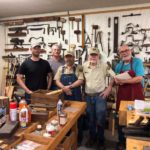
- Apprentice Steve Eikerman (third from left) and master woodworker James Price (second from right) stand with other VIPs (Volunteers in Parks) at the Ozark National Scenic Riverways workshop in 2019. Photo courtesy of James Price.
-
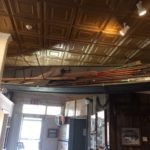
- Full-size johnboat filled with paddles on exhibit at Heritage Museum and Welcome Center in Doniphan, Mo. 2018

